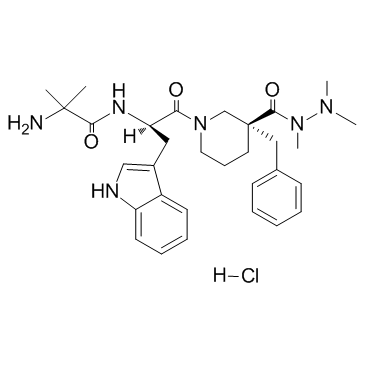
Anamorelin hydrochloride
CAS No. 861998-00-7
Anamorelin hydrochloride( RC-1291 hydrochloride | ONO-7643 hydrochloride | RC1291 hydrochloride | ONO7643 hydrochloride | RC 1291 hydrochloride | ONO 7643 hydrochloride )
Catalog No. M16239 CAS No. 861998-00-7
A non-peptide, centrally-penetrant and selective agonist of GHSR with appetite-enhancing and anabolic effects.
Purity : >98% (HPLC)
 COA
COA
 Datasheet
Datasheet
 HNMR
HNMR
 HPLC
HPLC
 MSDS
MSDS
 Handing Instructions
Handing Instructions
| Size | Price / USD | Stock | Quantity |
| 2MG | 39 | In Stock |


|
| 5MG | 60 | In Stock |


|
| 10MG | 87 | In Stock |


|
| 25MG | 133 | In Stock |


|
| 50MG | 168 | In Stock |


|
| 100MG | 222 | In Stock |


|
| 200MG | Get Quote | In Stock |


|
| 500MG | Get Quote | In Stock |


|
| 1G | Get Quote | In Stock |


|
Biological Information
-
Product NameAnamorelin hydrochloride
-
NoteResearch use only, not for human use.
-
Brief DescriptionA non-peptide, centrally-penetrant and selective agonist of GHSR with appetite-enhancing and anabolic effects.
-
DescriptionA non-peptide, centrally-penetrant and selective agonist of GHSR with appetite-enhancing and anabolic effects; orally bioactive.Growth Hormone Deficiency Phase 3 Clinical(In Vitro):In the FLIPR assay, Anamorelin (ANAM) shows significant agonist activity on the ghrelin receptor, with EC50 value of 0.74 nM. No significant antagonist activity is observed with Anamorelin at concentrations of up to 1,000 nM. In the binding experiments, Anamorelin binds to the ghrelin receptor with a binding affinity constant (Ki) of 0.70 nM. In the competition assay with radiolabeled ibutamoren (35S-MK-677; another ghrelin receptor agonist) Anamorelin (ANAM) is also found to bind with high affinity to the ghrelin receptor (IC50=0.69 nM). In rat pituitary cells incubated with Anamorelin, there is a dose-dependent stimulatory effect on GH release and the potency (EC50) is 1.5 nM. Anamorelin is screened for activity against a set of over 100 receptors, ion channels, transporters, and enzymes. Anamorelin demonstrates binding to the tachykinin neurokinin 2 (NK2) site (IC50=0.021 μM); however, a subsequent NK2 functional assay demonstrates no functional activity. (In Vivo):In rats, Anamorelin (ANAM) at an oral dose of 3, 10, or 30 mg/kg once daily significantly increases both food intake and body weight from Day 2 to Day 7 of treatment compared with the vehicle control. The cumulative change in food intake and weight gain increases dose-dependently, and these changes are significant at all dose levels (P<0.05) compared to the control. Administration of Anamorelin at a single oral dose of 3, 10, or 30 mg/kg induces a dose-dependent increase in plasma GH levels and GH AUC0-6h in rats.
-
In VitroIn the FLIPR assay, Anamorelin (ANAM) shows significant agonist activity on the ghrelin receptor, with EC50 value of 0.74 nM. No significant antagonist activity is observed with Anamorelin at concentrations of up to 1,000 nM. In the binding experiments, Anamorelin binds to the ghrelin receptor with a binding affinity constant (Ki) of 0.70 nM. In the competition assay with radiolabeled ibutamoren (35S-MK-677; another ghrelin receptor agonist) Anamorelin (ANAM) is also found to bind with high affinity to the ghrelin receptor (IC50=0.69 nM). In rat pituitary cells incubated with Anamorelin, there is a dose-dependent stimulatory effect on GH release and the potency (EC50) is 1.5 nM. Anamorelin is screened for activity against a set of over 100 receptors, ion channels, transporters, and enzymes. Anamorelin demonstrates binding to the tachykinin neurokinin 2 (NK2) site (IC50=0.021 μM); however, a subsequent NK2 functional assay demonstrates no functional activity.
-
In VivoIn rats, Anamorelin (ANAM) at an oral dose of 3, 10, or 30 mg/kg once daily significantly increases both food intake and body weight from Day 2 to Day 7 of treatment compared with the vehicle control. The cumulative change in food intake and weight gain increases dose-dependently, and these changes are significant at all dose levels (P<0.05) compared to the control. Administration of Anamorelin at a single oral dose of 3, 10, or 30 mg/kg induces a dose-dependent increase in plasma GH levels and GH AUC0-6h in rats.
-
SynonymsRC-1291 hydrochloride | ONO-7643 hydrochloride | RC1291 hydrochloride | ONO7643 hydrochloride | RC 1291 hydrochloride | ONO 7643 hydrochloride
-
PathwayGPCR/G Protein
-
TargetGHSR
-
RecptorGHSR
-
Research AreaEndocrinology
-
IndicationGrowth Hormone Deficiency
Chemical Information
-
CAS Number861998-00-7
-
Formula Weight583.1645
-
Molecular FormulaC31H43ClN6O3
-
Purity>98% (HPLC)
-
SolubilityDMSO: ≥ 28 mg/mL
-
SMILESCC(C)(C(=O)NC(CC1=CNC2=CC=CC=C21)C(=O)N3CCCC(C3)(CC4=CC=CC=C4)C(=O)N(C)N(C)C)N.Cl
-
Chemical Name3-Piperidinecarboxylic acid, 1-[(2R)-2-[(2-amino-2-methyl-1-oxopropyl)amino]-3-(1H-indol-3-yl)-1-oxopropyl]-3-(phenylmethyl)-, 1,2,2-trimethylhydrazide, hydrochloride (1:1), (3R)-
Shipping & Storage Information
-
Storage(-20℃)
-
ShippingWith Ice Pack
-
Stability≥ 2 years
Reference
1. Northrup R, et al. Support Care Cancer. 2013 Sep;21(9):2409-15.
2. Zhang H, et al. Expert Opin Pharmacother. 2015 Jun;16(8):1245-53.
3. Pietra C, et al. J Cachexia Sarcopenia Muscle. 2014 Dec;5(4):329-37.
molnova catalog



related products
-
TAPI-1
TAPI-1, an ADAM17/TACE inhibitor, inhibits shedding of cytokine receptors.
-
Anamorelin
A non-peptide, centrally-penetrant and selective agonist of GHSR with appetite-enhancing and anabolic effects.
-
Ibutamoren mesylate
A non-peptidic, poten and selective, orally-active agonist of the ghrelin receptor (GHSR) with EC50 of 1.3 nM (releases GH from rat pituitary cells).



 Cart
Cart
 sales@molnova.com
sales@molnova.com


